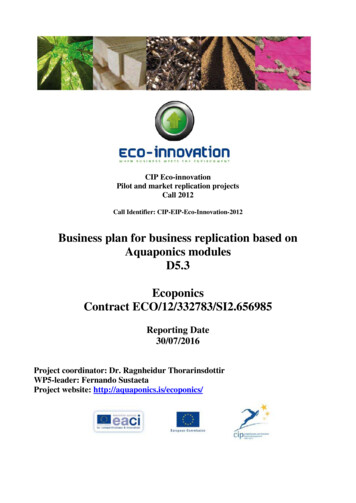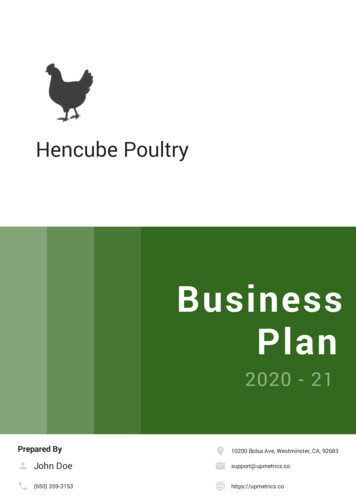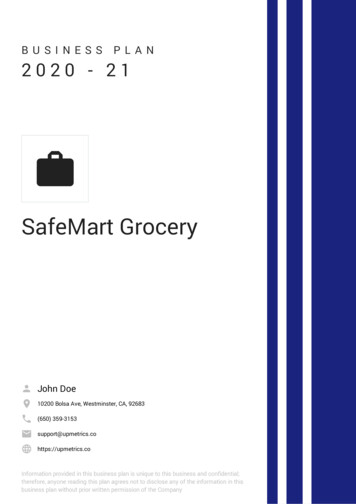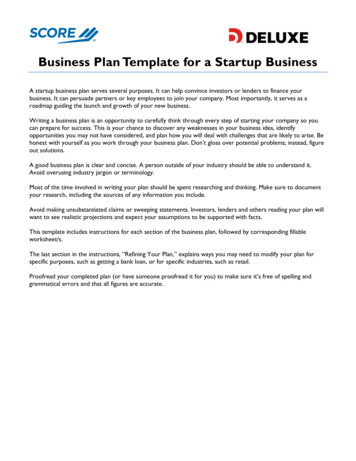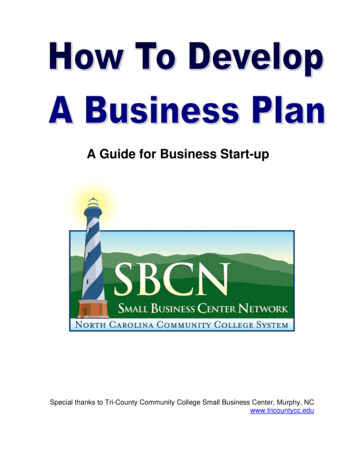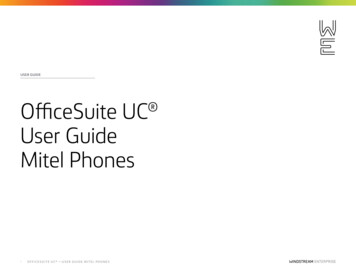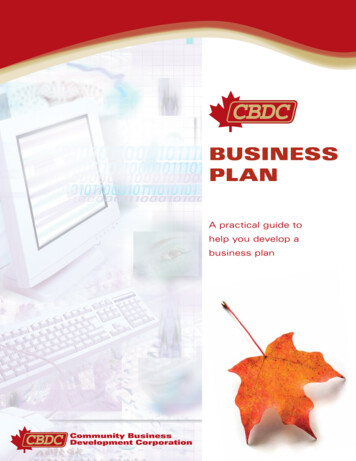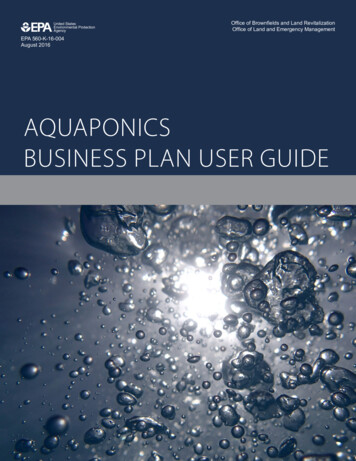
Transcription
United StatesEnvironmental ProtectionAgencyOffice of Brownfields and Land RevitalizationOffice of Land and Emergency ManagementEPA 560-K-16-004August 2016AQUAPONICSBUSINESS PLAN USER GUIDE
Aquaponics Business Plan User GuideContentsUser Guide Introduction . 1Before Beginning the Aquaponics Business Plan User Guide . 3Overview. 4Organization and Management . 6Marketing Strategy . 7Operating Strategy .12Financial Strategy.19List of Provided Worksheets .22Aquaponics Business Plan User Guidei
User Guide IntroductionIn 2011, the U.S. Environmental Protection Agency(EPA) released the Urban Farm Business PlanHandbook (Handbook) to provide guidance fordeveloping a business plan for the startup andoperation of an urban farm. While the Handbookacknowledged aquaponics as a method of producingfood in an urban environment, the Handbook generallyfocused on food and non-food related cultivatedagriculture. Since development of the Handbook,communities have expressed a growing interest inurban aquaponic farms as a sustainable method toprovide a source of healthy, fresh, and cost effectiveprotein and vegetables to the local community, whileproviding job and educational opportunities forcitizens. Increased interest in urban aquaponic farmscan be attributed, in part, to the ability to utilizebrownfields and other underutilized properties andbuildings in or near large population centers foraquaponics operations. This positioning is crucial toovercoming food insecurity and in providing new workopportunities for underserved populations, particularlyamong urban food insecure areas.Figure 1: Aquaponic operations in the District of ColumbiaPhoto Source: East Capitol Urban FarmAs with a cultivated agriculture urban farm, anurban aquaponic farm can be established asnon-profit, community or neighborhood-basedurban farm or for profit urban farm business. Ineither case it is important for those establishingan urban aquaponic farm to develop a plan forthe start-up and operation of the farmregardless of whether it is intended to be forprofit or non-profit.A business plan serves as an internalplanning tool that maps out the strategiesfor the startup and operation of a business,tracks progress of the business against itsgoals, and provides information to externalstakeholders important to the successfulstartup and operation of the business (e.g.,investors and funding sources).Because of the differences in production systemsbetween cultivated agriculture and aquaponics, theAquaponics Business Plan User Guide 1 (User Guide)has been developed to provide guidance fordeveloping an operating strategy specific to anaquaponic farm. This User Guide is modeled after theoriginal Urban Farm Business Plan Handbook andprovides an outline and guidance for the development of a business plan for an aquaponic farm. Somesections of the original Urban Farm Business Plan Handbook were modified to address aquaponicdifferences, while other sections keep the original text of the Handbook.This User Guide emerged from a dynamic project partnership between EPA Region 3, Delaware StateUniversity, Kent Economic Partnership, Kent Community Gardens Collaborative and Delaware Division ofPublic Health.This User Guide has been prepared for informational purposes only. EPA and the contractor team that prepared this report relied on outsidesources for information and data. Although all best efforts were used to confirm the information and data used to complete this report, norepresentation or warranties are made as to the timeliness, accuracy or completeness of the information contained herein or that the actualresults will conform to any projections or recommendations contained herein. All areas are approximate. Any reliance upon this material shallbe without any liability or obligation on the part of EPA or its contractors, Vita Nuova LLC and SRA International, a CSRA company.1Aquaponics Business Plan User Guide1
How Should the User Guide and Worksheets Be Used?The Aquaponics Business Plan User Guide (this document) provides guidance for developing a businessplan for the startup and operation of an urban aquaponic farm. The information provided is applicableregardless of whether the farm is to be operated as a non-profit or for-profit business. The followingoutline the five sections of the User Guide and which ones are updated for aquaponics: Overview – provides statements of the vision, mission and goals for the farm. The worksheetswere updated for aquaponic farm planning.Organization and Management – describes the ownership structure of the business and howthe business will be organized and managed. Worksheets and text are original to the UrbanFarm Business Plan Handbook.Marketing Strategy – identifies the products to be produced, provides an analysis of the marketfor the products and the potential competition for the products, and describes the approach forpackaging, distributing, and promoting the product. Worksheets and text are original to theUrban Farm Business Plan Handbook.Operating Strategy – describes the approach for product management, farm size and capacity,physical and human resources, regulatory requirements. The worksheets were updated torecognize the differences in production systems between cultivated agriculture and aquaponics.Financial Strategy – Provides estimates of income and expense, anticipated profit and loss, fixedasset requirements, potential sources of funds, and potential risks to the success of thebusiness. Worksheets and text are original to the Urban Farm Business Plan Handbook.This User Guide describes what information should be collected, evaluated, and presented in eachsection of the business plan. The User Guide is designed to be used side-by-side with the accompanyingAquaponic Business Plan Worksheets. As the User Guide describes each section of the business plan,there are references to worksheets that should be filled out in order to fully develop that section of thebusiness plan. A list of all of the provided worksheets is listed at the end of the User Guide. The UrbanFarm Business Plan Handbook and Worksheets Appendix B helps users understand how to fill in theworksheets and demonstrates hypothetical information to serve as a useful example of the level ofdetail and background research required to develop a business plan. The Aquaponics Business PlanWorksheets provide a framework in which to compile and organize the information needed to draft abusiness plan. There are two files that comprise the Worksheets:1.2.Aquaponic Business Plan Worksheet.doc (Microsoft (MS) Word ). This file contains blankworksheets that when completed will provide the information needed to write a businessplan. Worksheets 1-16, 18-22, and 28-29 are contained in this file. A list of all worksheets isprovided in that file.Aquaponic Business Plan Worksheet.xls (Microsoft (MS) Excel ). This file containsspreadsheets with formulas to help calculate expenditures and revenue. Worksheets 17 and23-27 are contained in this file.The information presented in the following sections of this User Guide is intended to be representativeof the information needed for the development of a business plan; however, the specific goals and plansfor any individual farm may require more or less information be provided for their particular plan.Aquaponics Business Plan User Guide2
Before Beginning the Aquaponics Business Plan User GuideBefore beginning the development of your business plan, think about the primary reasons for starting anurban farm. Documenting your reasons for starting the farm will help you focus the business plan andidentify the issues, the resources and the expertise that will be needed to develop the business plan.Finally, think about the values that you bring to the business and the values that are important to thesuccess of the business. Consider the following questions:Do you have crop growing or farm experience that will assist in your farm operations or will youneed to secure that expertise elsewhere?Do you intend to produce food, animal husbandry, aquaculture, aquaponics, or non-foodproducts or some combination of products?Do you have a property or are you in the process of selecting a location?Are you developing the farm as a community-based, non-profit business that will involvecommunity members in the operation?Are you developing the farm as a for-profit business and income source?Are you developing the farm as a family-run business and source of income?Is there a particular expertise or product that you want to commercialize?Are you creating the farm to provide produce for another business, such as an institution orrestaurant?Who will be part of your planning team?Do you have the expertise to develop marketing, operating, human resource, and financialstrategies necessary for the business plan or to help in the start up of the business?Are you going to need expertise to address environmental and cleanup issues that may beassociated with an urban property you intend to farm?Do you need to hire expertise to develop the strategies, conduct surveys, or plan thedevelopment?Do you need financial resources to obtain this expertise?Is there an economic motivation for this farm?Are you hoping to generate a profit, break-even, or will the farm require a source of charitableincome?Is the farm to be community-focused?To what extent are environmental issues related to the operation of the farm a consideration,such as organic fertilizers and resource use?Use Worksheet # 1 (Before You Begin) to document your reasons, expertise and resource needs.Aquaponics Business Plan User Guide3
OverviewThe overview introduces the reader to the businessplan, provides your vision and mission for the farm, andsummarizes your goals for the farm. The overview isdivided into four sections: IntroductionVision StatementMission StatementGoalsFigure 2: Example Urban FarmData source: Image via Flickr, courtesy of David BarrieIntroductionThe introduction describes the purpose of the business plan and the key issues addressed by the plan. Itprovides the reader with an understanding of what information is contained in the business plan and ageneral description of the plan development process.Consider the following questions: Is the business plan an internal organizing tool, a tool for communicating outside the proposedbusiness, or a combination of both?Is there information that is missing or unable to be identified at this stage of the planningprocess?Who are the members of your business planning team?Who was involved in the planning process?What is the planned size of the company and is future growth anticipated?What is the time frame considered in the business plan (at minimum the plan should consider a5-year time frame)?Is it to be a for-profit or non-profit business?Are there potential risks for the start up of this business?Use Worksheet # 2 (Introduction) to document the information to include in the introduction.Aquaponics Business Plan User Guide4
Vision StatementThe vision statement is an inspirational statement that describes your vision for the future of the farmand how your values will be incorporated into the farm. It focuses on the future and provides a directionfor the farm and the community in which it operates. It provides clear decision-making criteria.Consider the following questions: What economic, environmental, or community values are important to the success of the farm?In a general sense, what products or services do you expect to provide?How will the community benefit from these products or services?How will operating practices enhance the environment?Use Worksheet # 3 (Vision) to document the information to include in the vision statement.Mission StatementThe mission statement is a simple statement that communicates the fundamental purpose andexpectations for the farm to its customers and others outside of the business. It is a set of guidingprinciples that describes the overall goals of the business and serves as a benchmark. It incorporatesmeaningful and measurable criteria addressing concepts such as values of the business, public image,the target market, products or services, the geographic extent of the business, and expectations ofgrowth and profitability. It provides an understanding of what the business aspires to be and what thebusiness will be known for in the future.Use Worksheet # 4 (Mission) to document the information to include in the mission statement.GoalsThe goals describe what is to be achieved by the business in the future. Goals can be expressed in termsof time, such as short-term and long-term goals. For a start-up business, short-term goals may befocused on the startup of the business and achieving a certain level of production income. Long-termgoals can reflect plans for growth. Goals address potential products, what the farm will look like, whowill be involved in operations, and your expectations from the business. The goals reflect what youwould like to achieve and when you would like to achieve them. They do not identify how this will beaccomplished. Clearly identified goals can motivate, help to mitigate
detail and background research required to develop a business plan. The Aquaponics Business Plan Worksheets provide a framework in which to compile and organize the information needed to draft a business plan. There are two files that comprise the Worksheets: 1. Aquaponic Business Plan Worksheet.doc (Microsoft (MS) Word ). This file contains blank
